What is a chiller: device features, selection and installation rules
When considering the issue of cooling or heating your own private home, it makes sense to find out what a chiller is.This alternative to air conditioning systems is practically not used for individual small rooms, but for a spacious cottage it can be a very profitable solution.
The article we presented describes in detail the operating principle of this type of climate control equipment. The rules for assembling and constructing a system that forms the microclimate in the room are given. Taking into account our recommendations, you can easily choose the optimal model.
The content of the article:
Chiller operating principle
Chillers are a type of refrigeration machines that are used to cool a variety of liquids. Most often, these units are used in industry, but they are also suitable for air conditioning in large residential buildings, shopping complexes, offices, etc.
In combination with fan coil units, chillers perfectly perform the role of a central air conditioner. If in traditional air conditioners freon directly cools the air, then with chillers everything is somewhat different.
Here, thermal energy is transferred using ordinary water. To prevent it from freezing, a mixture with antifreeze, for example, antifreeze, can be used. The chiller works thanks to the evaporator, compressor and condenser that are part of it.
Water and refrigerant flow through the evaporator. The latter absorbs the thermal energy of the water and boils. The refrigerant turns into gas and the water cools. After this, the vaporous refrigerant enters the compressor, where, under the influence of compression forces, it is heated and mixed with oil.
This composition is then moved to the condenser, where it gives up a significant part of the thermal energy and turns into liquid. The refrigerant then enters the filter drier to remove excess moisture.
The pressure of the liquid refrigerant decreases as it moves through the expansion valve. Here it again turns into a vapor state and is fed into the evaporator to repeat the cycle.
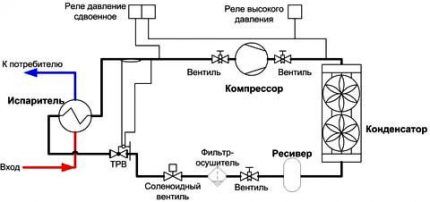
Thus, the compressor is designed to compress and move the refrigerant, which sequentially moves through the air condenser and evaporator, then heating and simultaneously cooling the water, then cooling.
The condenser in this system plays the role of a heat exchanger, through which the thermal energy absorbed by the refrigerant is transferred to the environment.
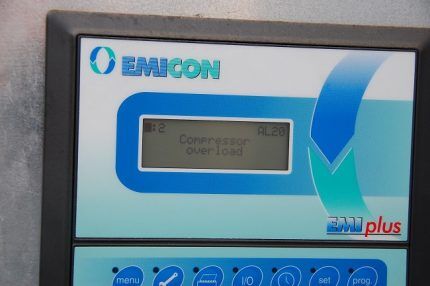
Excessive pressure on the refrigerant circuit can damage the system. To monitor this indicator, a high pressure switch is used, as well as a pressure gauge, which allows you to visually monitor the condition of the system. A liquid receiver is designed to store refrigerant.
The filter drier removes not only water vapor from the refrigerant, but also foreign contaminants. A solenoid valve is designed to control the flow of refrigerant, which automatically shuts off the system when the compressor stops operating.
This protects the system from liquid refrigerant entering the evaporator. As soon as the compressor turns on, the valve opens. The system has a sight glass that allows you to visually monitor the condition of the refrigerant.
If air bubbles are visible in the liquid flow, it means that the amount of freon needs to be increased. To monitor the humidity of the refrigerant, sensors with color indication are used. And the amount of refrigerant entering the evaporator is regulated using a thermostatic valve.
To increase system capacity, it is sometimes recommended to use a hot gas bypass valve. This item is not always included in the package.
To ensure that the amount of water in the system remains sufficient for its operation, an automatic water topping system is installed in industrial chiller models. The circulation of water inside the circuit is ensured by a coolant pump.
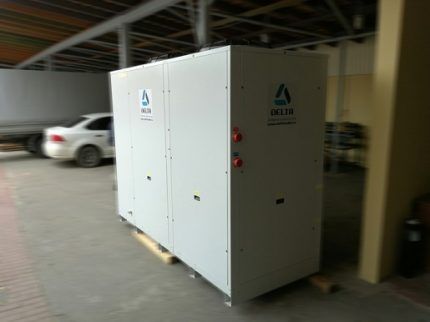
Previously mentioned fan coil units are devices through which cooled air is supplied to individual rooms. Install fan coils indoors. They are mounted on the wall, ceiling and even on the floor. Several fan coil units can be connected to one chiller.
Their specific number is determined by the number of rooms requiring air conditioning. But at the same time, the chiller’s performance must ensure a certain number of fan coil units.
For chiller and fan coil connections Ordinary water pipes are used in the overall system. This distinguishes them from traditional split systems, for which only expensive copper communications are suitable.
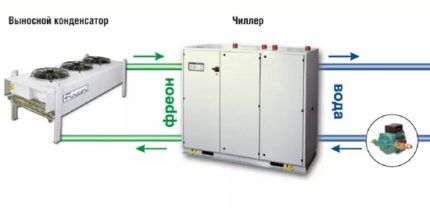
An important part of such a device is the pump that circulates the refrigerant. The higher the performance of this pump, the greater the distance between the chiller and fan coil units. This is convenient because it increases the number of options when choosing a suitable location for the chiller.
The unit is often placed on the roof of a building, but if desired, it can be placed in a special utility room. This allows you to completely preserve the appearance of the existing façade of the building. Split systems they almost never provide such an opportunity.
Chillers are classified depending on various characteristics:
- by type of refrigeration cycle such as absorption and vapor compression;
- by design as a monoblock or a system with a remote capacitor;
- by type of condenser cooling, which can be air or water;
- according to the connection diagram;
- by the presence or absence of a heat pump.
Chillers that have a heat pump in their design are suitable not only for air conditioning in a room, but also for heating it. They are designed for use throughout the year.
How to choose the right chiller?
For the needs of a large cottage, experts recommend using a chiller with a water-cooled condenser. Such devices have a simpler design than their air-cooled counterparts, and accordingly, they are cheaper.
The air-cooled chiller design includes a fan (axial or centrifugal) to draw air from the room in which the device is installed.
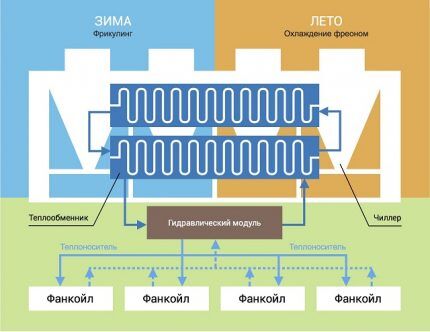
To cool the condenser with water, you can use local water resources: rivers, lakes, athesian wells, etc. If for some reason there is no access to such sources, an alternative option is used: a coolant made of ethylene or propylene glycol.
Coolers of this type are ideal for use in the cold season, when ordinary water simply freezes.
The choice between a chiller in the form of a monoblock, when the compressor, evaporator, and condenser are enclosed in a common housing, and the option when the condenser is installed separately, is not so clear. A monoblock is easier to install; in addition, the performance of units of this type can be quite high.

Remote systems are installed in different places: the chiller itself is in a utility room inside the building (even in the basement), and the condenser is outside. To connect these two blocks, pipes are usually used through which freon circulates. This explains the increased complexity of installing the system, as well as additional material costs for installation.
But installing a chiller with a remote condenser uses less indoor space, and these savings may be necessary. When choosing a suitable device, you should also take into account the additional functions that the device is equipped with.
Popular and useful add-ons include:
- control and regulation of water balance in the system;
- purification of water from unwanted impurities;
- automated filling of containers;
- monitoring and correction of internal pressure in the system, etc.
Finally, it is imperative to evaluate the cooling capacity of the chiller, i.e. its ability to extract thermal energy from the working fluid. Specific quantitative indicators are usually indicated in the technical data sheet of the product. The cooling capacity of each specific chiller-fan coil system is calculated separately.
This takes into account the maximum and minimum temperature indicators, chiller power, pump performance, pipe length, etc. These are only general recommendations for choosing chillers. In each specific case, you should consult with an experienced specialist who can take into account various nuances and help you make the right choice.
Features of installation of such devices
Only an experienced specialist can save on installing a chiller.All other owners of this device will have to pay for the services of professional installers, since in this matter any mistake can be fatal. Installation begins with a thorough study of all technical documentation and manufacturer’s recommendations.

After this, proceed directly to the installation. For the chiller, you should choose a support platform that can support the weight of this device.
A frame is mounted on the site, the position of which is carefully verified using a level. If there is no site with the required characteristics, an area suitable for installation should be concreted and a frame installed on it.
In this case, the vibration effect that occurs during operation of the chiller should be taken into account. The platform and frame must be installed in such a way that vibration is not transmitted to other building structures. Other elements of the system can also have an impact: pipes, air ducts, hydraulic module, etc.
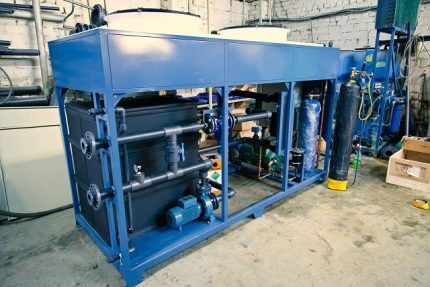
If the installation of the chiller is planned in a utility room inside the building, it is necessary to build a foundation that will rise above the floor level. This will reduce the overall inertia of the system, reduce the vibration impact, and improve the weight distribution of the unit.
The chiller itself is mounted on special spring or rubber supports in order to dampen vibration effects.Another layer of rubber is placed under these supports, then the structure is secured with anchor bolts. When deciding on a place to install the chiller, you should remember that there should be free space around the unit.

It will provide access to mechanisms for maintenance. In addition, air should circulate freely around the device to improve cooling of the capacitors. If the chiller is installed outside a building, it must be protected from contamination, such as fallen leaves.
If debris gets into the heat exchanger, it will cause the system to malfunction and cause serious equipment damage. It is unacceptable for the chiller body to be touched by foreign objects or communications, as vibration effects may be transmitted to them. Another important point when installing the chiller outside is the direction of the wind.
When installing indoors, the noise emission generated during operation of the unit should be taken into account. It makes sense to take care of additional sound insulation and think about how excess noise will affect neighboring rooms. It is not recommended to install the chiller next to living rooms.
If you plan to install other units next to the chiller, you need to make sure that the mechanism is not exposed to excessive heat, and that there are no obstacles to the free movement of air flows.
When installing the chiller externally, a special casing is used that protects the device from exposure to weather factors.An evaporator is placed inside the casing, a place is provided for mounting compressors on the side, and the condenser is installed on top.
In the same way, the unit is installed on the roof of the building. For indoor installation, the casing, of course, is not needed, but if in this case a model with a remote condenser is used, then part of the installation work is performed outside.
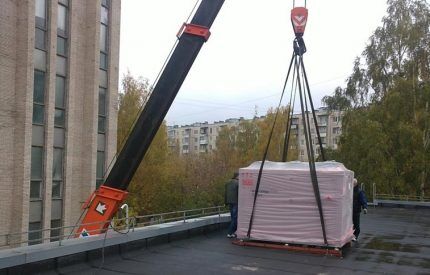
When studying the technical documentation, you should pay attention to the order of installation of the frame under the chiller. For some high-performance models, special vibration supports are used, which do not need to be additionally secured with anchor bolts.
For individual units, it is not necessary to pour a separate foundation; it is enough to correctly install the frame and secure the device with bolts.
Couplings are usually used to connect pipes to the chiller pipes, since the diameter of these communications is small. The chiller is connected to the pipelines only after the unit is installed on the foundation and vibration supports. You should not perform this step in advance so as not to damage communications.
Conclusions and useful video on the topic
A video with a presentation of the industrial model of the CHA-14 chiller can be viewed here:
An industrial chiller is a rather complex device, but with proper installation and maintenance it can serve flawlessly for many years. In order not to make mistakes during the equipment installation process, it is better to contact a specialized company.
Please write comments in the block form below.Tell us about how you installed a similar climate system in your home or office, and share useful information on the topic of the article. Ask questions, report any errors found in the text, post photos on the topic.




Installing a chiller, of course, is not the easiest thing, you still need to have skills. It is necessary to calculate the weight on the supporting area so that the area can support the blocks. Similarly, you need to make a foundation for installing a chiller. You also need to think about how to subsequently avoid possible vibrations. The chiller needs space to operate properly, and at the same time you need to think about a future design for possible repairs.
As correctly said, the chiller does not spoil the appearance of the building, unlike conventional air conditioners, stuck on in a chaotic manner. This is especially noticeable in the historical parts of the city. This is a fairly expensive installation, but given the multi-story buildings and the number of apartments, why not include it in the cost per square meter.
Why should additional options be included in the price of housing? Some people need this cooling of the apartment, while others will get by with a homemade paper fan.
In fact, it is a common phenomenon when additional options in new-build apartment buildings are included in the cost of housing. I understand that someone may not need such climate control, but in such cases apartments are sold without such a cooling system. The real estate market is oversaturated, so it's easy to find housing that doesn't have options you don't need.
And if in the future you are still interested in such a solution, then there are mini-chillers that can be installed even on the balcony, for example. But installation on the roof is a little more complicated; in this case, you will have to resolve the issue through the management company.
In the article, Valery, there is a section “How to choose the right chiller”, beginning with the words: “For the needs of a large cottage...”. This is a key phrase that defines the scope of application of the chiller - large private houses, semi-industrial and industrial facilities. But the main problem for an apartment building is payments for the service. After all, there are no cooling meters.
Payment will include
water consumption + electricity + something else
Do hotels use chillers? Or something different?
And in residential buildings, where there is cooling, but there are no fans on the walls that spoil the appearance, then they are used?